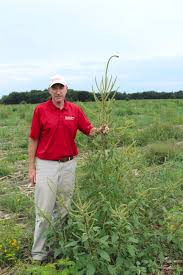(Amaranthus palmeri)
Description: Palmer Amaranth is a destructive species from the Pigweed family that was introduced in Iowa in CRP seed mixes and threatens crop production. Palmer amaranth grows very quickly (2-3 inches a day) and reaches a height of 6-8 feet. Palmer Amaranth can be difficult to differentiate from Redroot or Smooth Pigweeds (Amaranthus retroflexus/Amaranthus hybridus) and Waterhemp (Amaranthus tuberculatus), so careful identification is needed. Palmer Amaranth has much longer leaf petioles (up to 3x length of the egg shaped leaf) as well as hairless stems, petioles, and leaves. In addition, Palmer Amaranth’s seed heads are much larger (up to 2 feet) and are covered by sharp bracts.
Distribution: Palmer Amaranth is now distributed across Iowa, although not in large infestations (yet).
What’s the problem? Because Palmer Amaranth can severely impact yield in corn and bean fields, this species is required to be eradicated. Studies have shown a nearly 91% yield decrease in corn and 78 % yield decrease in soybeans. Palmer Amaranth is difficult to control with conventional agricultural methods and has shown a high degree of chemical resistance.
Management methods: Regular scouting for developing plants will help prevent seed production- only female plants will produce seeds heads that can produce 2 Million seeds per plant. Remove female seed heads from the field and dispose of them in such as way to destroy them (burning/compost/bury). Scout for plants that “don’t look right” and contact ISU Extension as soon as possible if you find a plant you suspect to be Palmer Amaranth. Palmer Amaranth seed can easily be transported by equipment and water, so careful cleaning of equipment and proper soil conservation efforts are critical.
Related articles:
Palmer Amaranth Now Identified in at Least Nine Iowa Counties
Palmer Amaranth on the Move



